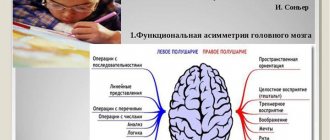The first signs of schizophrenia in a teenager can easily be confused with age-related changes and their accompanying unstable emotional state. For example, a boy or girl may act distant and withdrawn or, conversely, grimace and fool around. Parents make allowances for the difficult period of development and do not take odd behavior seriously.
Important
With rare exceptions, teenagers are typically characterized by a desire to communicate with peers, to assert themselves in society, and to try new things. But apathy (indifference), lack of initiative and lack of motivation for any activity can be a sign of a serious illness.
In turn, the hidden genetic pathology of the nervous system manifests itself precisely in adolescence. The true causes can be determined by timely and accurate diagnosis. If the presence of the disease is confirmed, you need to consult a psychiatrist for treatment.
Schizophrenia in adolescents - signs
Adolescent schizophrenia is a process associated with the formation in a teenager of a pathological mental and emotional state in the perception of the surrounding reality. At the beginning of the development of schizophrenia in adolescents, signs of psychopathy come to the fore: disobedience, aggressiveness, refusal to attend school, sexual deviations.
The main sign of schizophrenia in adolescence is the intensification of negative emotions almost instantly, the occurrence of disturbances in thinking, severe autism, and a decrease in general activity. Adolescent and adult schizophrenia differ significantly. In this age category, the onset of schizophrenia rarely manifests itself in the form of hallucinations and delusions.
Schizophrenia in adolescents
- paranoid - manifests itself as delusion in the form of incorrect interpretation of events and one’s own experiences, dysmorphomania is common (discovery of a defect in appearance that actually does not exist);
- simple - can begin with a difficult character and outbursts of aggression, followed by a sharp decrease in activity and poverty of interests;
- residual - against the background of the absence of acute manifestations of schizophrenia, lethargy, low social activity, and indifference to one’s appearance remain;
- hebephrenic - manifested by elements of child behavior: grimacing, mannerisms, extreme manifestations of autism;
- catatonic – currently quite rare; there is stupor or unproductive motor activity, negativism, freezing in unusual positions.
According to the type of course, schizophrenia is divided into continuous and paroxysmal.
When studying schizophrenia, the comparative age approach remains one of the most productive [1–3]. It allows us to penetrate more deeply into the essence of the manifestations of schizophrenia in all their clinical diversity, to determine the conditions for the manifestation of the disease and the links of its pathogenesis.
The profound changes that occur in the body's reactivity, in its neurobiological and immunological systems during critical age periods, have a pathogenetic and pathoplastic effect on the clinical picture, course and outcome of all mental illnesses. This position, which is of a general biological nature, is especially significant when addressing questions about the characteristics of psychopathology, the clinical picture and course of schizophrenia, which manifests itself in adolescence (16-25 years). As many researchers have noted [3–5], the psychological and biological characteristics of this age period significantly modify the clinical picture of manifesting schizophrenia, exerting a pathoplastic and pathogenetic effect, which manifests itself in the form of specific psychopathological features. Revealed precisely in adolescence, they are leveled out as they grow older. The most obvious reason for maintaining such a focus of scientific research is epidemiological data from different years, which invariably proves that the peak manifestation of endogenous psychoses of the schizophrenia spectrum occurs during adolescence [6-8].
According to epidemiological data [9], among the main forms of juvenile schizophrenia, paroxysmal forms make up more than half - 57.1% (of which recurrent - 12.7%), continuous - 42.9%. At the same time, the age-related pathomorphosis of schizophrenia manifests itself in all its forms.
The pathoplastic influence of the youthful age factor in the clinic of paroxysmal schizophrenia is reflected primarily in the clinical picture of manifest attacks, which in modern literature are referred to as the “first psychotic episode”. This category includes manifest attacks of schizophrenia and schizoaffective psychosis.
When studying the first attacks in adolescence [10-16], psychopathological features were identified that were caused by the pathoplastic and pathogenetic influences of the pubertal stage of maturation: polymorphism of the clinical picture with incompleteness, fragmentation and variability of psychopathological symptoms; high representation of affective disorders of varying severity, which are characterized by a distinct age-related atypicality of manifestations; the frequency of catatonic disorders, which have a wide range of manifestations from symptoms of “minor catatonia” to generalized forms, accompanied, as a rule, by severe somatovegetative disorders; the predominance of acute sensory delirium with the rarity of attacks with systematized interpretative delirium; the presence of “pubertal features” in the picture of productive symptoms, which are manifested both in the themes of delusional and hallucinatory disorders, and in the frequency of occurrence of delusional fantasies and hallucinations of the imagination; the predominance of ideational automatisms in the structure of Kandinsky-Clerambault syndrome in comparison with sensory and kinesthetic ones; the dominance of autochthonous mechanisms of the occurrence of an attack over psychogenic and somatogenic ones; the protracted nature of the entire attack, as well as the stage of remission; high incidence of suicidal tendencies after the first psychotic attack; significant representation in the picture of attacks of cognitive disorders.
In studies of the first psychotic attacks in the last decade, a new standard has been established for the study of patients using paraclinical methods, including neurophysiological, neuroimaging, immunological, genetic, and psychological. This made it possible to identify a number of new biological and psychopathological correlations.
Polymorphism and incompleteness of psychopathological symptoms in the structure of the first psychotic attack in adolescence is indirectly reflected in the significantly greater heterogeneity in changes in the morphological and functional state of the brain in adolescent patients [17] in comparison with the corresponding indicators in older patients and with a longer duration of the disease . In general, the range of abnormalities in them turned out to be similar to the disorders characteristic of mature patients. In both age groups of patients, disturbances in the neurophysiological processes of information processing are observed [18, 19], reduction of gray matter and pathology of pathways in various areas of the brain [20]. It has been shown that the early onset of the disease is characterized by a greater reduction of gray matter in the frontal, temporal and parietal regions [21]. Some studies indicate qualitative differences - in adolescent patients, disturbances in the microstructure of the corpus callosum are observed mainly in its anterior sections, while in older patients - in the caudal areas [22]. When studying the neurocognitive symptom complex in patients with a first psychotic episode in adolescence, it was found that each of the syndromic types of attacks has its own characteristics [23]. Neuropsychological and neurophysiological data [23, 24] made it possible to establish both signs of damage to brain structures that are common to all syndromic types of first seizures, as well as their certain differences: in patients with the catatonic type of seizures, the pathological process involves predominantly the premotor and prefrontal parts of the cortex, with hallucinatory-type seizures. in the delusional type - the prefrontal and parietal sections, in the affective-delusional type - the parieto-occipital. When studying innate and acquired immunity at the time of manifestation of the first attack, it was revealed [25, 26] that in adolescence, in contrast to later ages, the manifestation of endogenous psychosis is accompanied by activation of innate immunity, the level of which is not associated with the psychopathological structure of the attack. The results of a pathopsychological examination of patients with juvenile schizophrenia after reduction of psychotic symptoms showed the dominance of a field-dependent style of cognitive activity, the predominance of inadequate personal self-esteem, and the absence of real plans for the future [27], which is a reflection of the pathoplastic influence of the age factor.
Follow-up studies have shown that the course of juvenile paroxysmal schizophrenia is characterized by a pronounced tendency to develop repeated attacks while maintaining the psychopathological features of the first attack in their syndromic structure, with the period of the most intense attack formation occurring in the first ten years of follow-up [10, 13-15, 28]. In a generalized integrative assessment of the outcome of the disease [28], at the time of follow-up, a “favorable” outcome (“recovery/restoration” - recovery according to E. Lauronen [29]) occurred in 18.7% of the studied patients. A “relatively favorable” outcome (“incomplete recovery” - partial recovery [29]), noted in 33.8% of patients, was characterized by the persistence of phases/attacks of the “cliché” type or with a gradual simplification of their psychopathological structure and high-quality remissions, with insignificant severity negative disorders and a high or previous level of social and labor adaptation. The “relatively unfavorable” outcome (moderate outcome [29]), noted in 30.2% of observations, was characterized by a progressive course or a course of the “cliché” type, but with more distinct negative changes, with a decrease in the level of social and labor adaptation or loss ability to work. An “unfavorable” outcome (poor outcome [29]), characterized by a progressive complication of the pattern of attacks or the transition of the disease into a chronic course with the presence of distinct negative changes, social maladaptation and loss of ability to work, was observed in 17.2% of patients.
A special place among all forms of juvenile schizophrenia is occupied by schizophrenia, which occurs in the form of a protracted atypical pubertal attack, which accounts for 12.5% of cases of schizophrenia in adolescence [30-37]. The clinical picture in these cases is determined by specific hypervaluable-delusional psychopathological syndromes, demonstrating distinct dynamics from exaggerated pubertal crisis manifestations to pathologically modified ones - up to the psychotic level, which are a reflection of a special pathogenetic mechanism for the development of endogenous symptoms associated with the maturation process.
Among the atypical pubertal seizures, expansive and sensitive ones can be distinguished. The first group includes heboid syndrome and the syndrome of “metaphysical intoxication”, the second group includes psychasthenic-like, dysmorphophobic, “youthful asthenic incompetence”, as well as with special sensitive ideas of relationship.
Heboid attack
characterized by a pathological exaggeration and modification to a psychotic level of psychological pubertal properties with a predominance of affective-volitional disorders, including the unleashing of drives that lead to actions contrary to generally accepted norms and pronounced maladjustment in society. An attack is distinguished from a pubertal crisis by grotesque, pretentious, caricatured behavior, meaningless opposition, reaching the point of total negativism, leveling of affective manifestations, “loss of spiritual resonance,” a “wood-glass” reaction, particular cynicism, rudeness, brutality of reactions, autochthonous mood swings , bipolar nature of affective reactions, lack of connection with psychogenicity or external influences, high proportion of procedural thinking disorders.
Attack with symptoms of “metaphysical intoxication”
characterized by the dominance in the mental life of the patient of abstract thoughts about the meaning of one’s own and human existence, about death and the legality of suicide. Identity crisis and existential search, which are one of the components of the pubertal crisis period, in this case are realized in the form of affectively charged one-sided intellectual activity, leading to various forms of social and labor maladjustment. Such patients are characterized by low productivity and a lack of connection between their premorbid personality characteristics and the nature of their new “hobbies.” Often these signs are combined with procedural symptoms (cognitive and obsessive-phobic disorders, senestopathies, phenomena of depersonalization and autism, individual hypnogogic hallucinations and hallucinations of the imagination).
Attack
with
dysmorphophobic
disorders is characterized by a painful exaggeration of the ideas of one’s physical and (or) mental imperfection to the level of overvalued and sometimes delusional dysmorphophobia. In the clinical picture, attention is drawn to the frequency of occurrence of autochthonous bipolar atypical affective disorders and procedural thinking disorders. Also, in most cases, emotional impoverishment and rigidity are detected.
Attack with psychasthenic-like disorders
is characterized by the appearance of previously unusual indecision and uncertainty in one’s actions and actions, difficulties in contact with a feeling of constraint and tension in public, heightened reflection, a feeling of change in one’s personality and detachment from reality (“loss of the sense of the real”). Such disorders are in dissonance with the premorbid personality.
With the development of a psychasthenic-like type
of attack
, the appearance of comorbid symptoms (depersonalization, obsessions, etc.), the addition of disorders from the range of mental automatisms and ideas of relationships to psychasthenic disorders, disturbances in thinking of the procedural type, and the emergence of bipolar affective disorders are characteristic.
Attacks with juvenile sensitive delusions of relation
are characterized by the dominance of a delusional conviction of one’s own moral inferiority, “delusions of moral ugliness”, “bad conscience”, with the formation of a specific “sensitive delusion of masturbants”, which in recent years has been supplemented by ideas of attitude regarding one’s own homosexuality that are similar in the mechanism of their emergence. The clinical picture of attacks is complemented by severe depressive disorders.
Attacks with “youthful asthenic failure”
are characterized by the dominance in the clinical picture of special cognitive disorders in the form of slowing and distortion of thought processes, a feeling of alteration of one’s intellectual activity, procedural disorders of thinking in the form of “influxes”, “breaks”, “blackouts”, “parallelism” of thoughts, chaotic flow of thoughts, even inability to make verbal contact. Against this background, patients experience difficulties in mastering educational material, failure to study, and their overall level of activity and productivity decreases. The clinical picture of such an attack is characterized by the presence of atypical depressive symptoms and slightly expressed other positive disorders (senestoipochondriacal, dysmorphophobic, ideas of attitude, etc.).
All of the listed variants of atypical pubertal attacks, developing within the framework of juvenile low-progressive schizophrenia, are characterized by a rather protracted, but at the same time relatively favorable course. The manifest state is completely limited to the stages of adolescence, at the end of which a stable remission occurs with signs of minor post-processual personality changes, such as mental juvenileism, deepening of the schizoid personality, some emotional leveling, and rigidity. In most cases, patients achieve full social and labor adaptation and professional success.
In previous studies [30], the listed attacks were classified within the framework of low-progressive schizophrenia, which is reflected in the domestic classification [31]. However, in modern international taxonomies ICD-10 and DSM-5, such conditions are considered outside the diagnostic criteria for schizophrenia. One part of them may qualify as a schizotypal disorder, the other – an affective disorder.
Only the age period discussed in this article is characterized by a special juvenile malignant form of schizophrenia, characterized by high progression with a rapid increase in negative disorders and the formation of severe forms of defective conditions [30, 38, 39]. This variant of the course, found in no more than 5-6% of patients with schizophrenia, is represented by four main forms: simple, hebephrenic, catatonic and paranoid. Its psychopathological manifestations and their dynamics are also determined by youthful age characteristics. Thus, in the structure of the initial stage, the presence of two phases was revealed - negative and productive [4]. The negative phase is represented mainly by a decrease in activity in the cognitive, motor and emotional spheres. Symptoms of the productive phase (obsessive-phobic, psychasthenic, overvalued and other disorders) appear in some cases soon, in other cases after a relatively long period of time. For the course of the initial stage, the following pattern has been identified: the longer and more pronounced the disorders of the first phase, the shorter and less pronounced the disorders of the second phase. In cases of dominance of negative disorders (“simplex syndrome”), the transition to the stage of hallucinatory-delusional or catatonic-hebephrenic manifestations occurs more quickly. In juvenile paranoid schizophrenia, it is relatively rare to observe a typical sequence of changes in syndromes. At the initial stage of the disease, instead of paranoid disorders, the clinical picture is dominated by neurosis-like and psychopathic-like ones. Moreover, the more significant the negative disorders, the less the severity of specific age-related syndromes.
It should be noted that also predominantly in adolescence, a special, febrile form of schizophrenia is observed [40], which consists of attacks of oneiric catatonia, characterized by a rise in temperature and a number of somatic disorders, which apparently is a reflection of the pathogenetic influence of the youthful age factor.
In juvenile schizophrenia, a special form of negative disorders has been described, represented by the features of mental infantilism (juvenilism), which manifests itself in the general appearance of patients, the nature of their emotional reactions, actions, and assessment of the environment [4, 10, 31, 41]. The severity of juvenileism depends on the degree of progression of the process and can be partial or total in nature. In addition, in juvenile schizophrenia, in some cases, there is a violation of physical and sexual development, which is not always accompanied by a delay in mental maturation.
Summarizing the data presented in this publication about the characteristics of psychopathology and the clinic of various forms of juvenile schizophrenia, we can formulate two main patterns of its course. On the one hand, there is a tendency towards a more severe course, characterized by high progression with an unfavorable outcome, which is especially pronounced in juvenile malignant schizophrenia. On the other hand, there are favorable variants of the course with an outcome that meets the modern criteria of “recovery”, both in low-progressive and paroxysmal-progressive and recurrent forms, which is associated with high compensatory reserves of the brain at this most important ontogenetic stage of development.
Today, one of the most pressing problems in clinical psychiatry of adolescence is the determination of the symptoms of the so-called prodromal phase (initial stage) of schizophrenia with the identification of criteria for an “ultra-high” risk of developing psychosis [42-44]. The researchers aim to reduce the period of “untreated psychosis” and consider the possibilities of “primary prevention of schizophrenia,” which means stopping the endogenous process before the onset of symptoms that meet the formalized diagnostic criteria for schizophrenia in accordance with ICD-10 and DSM-5.
In a special multidisciplinary study [45] of the characteristics of the initial stage in patients with juvenile paroxysmal schizophrenia, its significant duration, high heterogeneity, and amalgamation of its psychopathological symptoms with manifestations of pubertal crisis were established. There was a decrease in the level of premorbid functioning as we approached the manifestation of the disease with an increase in the proportion of overvalued disorders of specific youth content. Moreover, in many cases, a certain stereotype of changing the themes of the dominant ideational constructions was noted: ideas of dysmorphophobic content were often replaced by hypochondriacal ones, which over time somewhat lost their relevance, giving way to abstract reflections of a metaphysical nature. Overvalued disorders quite easily transformed into delusional phenomena, while the frequency of occurrence of depersonalization phenomena was noted - from “physiological”, associated with the gradual awareness of changes occurring in the body, to symptoms of a psychopathological level, which in many ways aggravate the severity of the described disorders of the initial stage. It was found that the patient's pre-manifest status correlates to the greatest extent with the severity of personality anomalies. With a premorbid personality anomaly at the level of psychopathy, maladjustment occurred in all areas of the patient’s activity. The initial stage was most often characterized by the predominance of heboid disorders with a significant proportion of depressive affect. With a pseudopsychopathic personality anomaly, the premanifest state could be regarded as a schizotypal disorder. In these patients, personality disharmony manifested itself most strongly, early ontogenesis was distorted, pathological episodes were most common among the selected groups, and were not associated with environmental influences. In patients with premorbid personality anomalies of the types described above, correlations were identified with a number of molecular genetic indicators [46-48], characteristic of schizophrenia and indicating a tendency towards an unfavorable course of the endogenous process. This made it possible to develop criteria for high and ultra-high risk of manifestation of schizophrenia spectrum psychoses in adolescence. High-risk criteria include: psychopathic personality anomaly with decompensation states in the presence of hereditary burden among first-degree relatives, which must be considered as an indication for molecular genetic examination. Ultra-high risk criteria include high-risk indicators in combination with some results of molecular genetic testing, which some authors [43, 49] consider as an indication for prescribing preventive antipsychotic therapy in low doses.
According to a number of modern studies, patients with juvenile schizophrenia (primarily men) are the group at the highest risk of suicidal behavior, with the bulk of suicidal mortality occurring in the first 10 years of the disease [50, 51]. Among the most significant risk factors for these patients are awareness of the disease with a feeling of hopelessness due to the presence of psychotic symptoms and its potential effect on the quality of life and its devastating consequences [50], as well as such therapy-associated phenomena as the presence of severe neuroleptic side effects and low compliance. A high level of impulsivity, as well as negative life events, among which the breakup of significant interpersonal relationships is of particular importance in adolescence, has a significant impact [52]. Substance abuse also facilitates the implementation of suicidal tendencies [50, 53]. The greatest predictive power in determining risk factors for suicidal behavior is the presence of a history of serious suicide attempts and a current depressive state [50, 54, 55].
In light of the significant achievements of modern psychopharmacotherapy, including from the point of view of its accessibility and demand by a significant part of the population suffering from mental illnesses, the question of the pathomorphosis of endogenous paroxysmal psychoses is of particular importance for the development of scientific knowledge [56, 57]. This problem is extremely relevant and complex when studying the youth population of patients with manifest conditions of schizophrenia, especially from the point of view of prognosis. A comparative analysis of the results of two follow-up studies [10, 28], conducted according to a general design with a 30-year interval at the Scientific Center for Mental Health, allowed us to establish a more favorable course of juvenile schizophrenia at the present time as a reflection of the general and therapeutic pathomorphosis of endogenous psychoses manifesting at a young age . Further development of this issue should make it possible to increase the efficiency of solving socially significant issues, including those related to the education and working ability of patients, at the earliest possible stages of the disease.
Psychological and biological characteristics of adolescence determine the need to take them into account when conducting treatment for schizophrenia spectrum diseases in this age period. As is known, in adolescence there are two opposite trends: on the one hand, the younger the patient, the easier it is to achieve trust in the doctor [58], and on the other hand, young patients (especially boys) show worse adherence to therapy compared to mature patients. age [59, 60]. A pattern has been revealed that the younger the patient, the more pronounced the side effects while taking psychotropic therapy. This position is confirmed by other researchers [61], emphasizing its validity both in relation to extrapyramidal effects and other side effects. Other factors that influence adherence to therapy in adolescence turned out to be significant - this is a more frequent lack of criticism of one’s condition than in mature patients and reluctance to take medications, primarily due to side effects (especially due to the “ mental parkinsonism”, manifested in the cognitive sphere, as well as due to disorders in the sexual sphere) [62]. Due to a certain immaturity of the cardiovascular system, tachycardia, impaired atrioventricular conduction, and hypotonic reactions, including collaptoid states, occur much more often in adolescent patients. There is also evidence for a higher risk of changes in the blood count in adolescence during clozapine therapy [63], as well as an increase in prolactin levels during olanzapine therapy, which is not typical for mature patients [64].
When treating schizophrenia spectrum diseases in adolescence, an integrated approach is required, combining psychopharmacotherapy with psychotherapeutic techniques specially adapted for the young population. Currently, basic principles have been formulated regarding approaches to organizing and conducting therapeutic activities in patients with juvenile schizophrenia [62, 65]: achieving a therapeutic alliance; timely prescription of neuroleptic therapy; personalized approach to therapy for each patient; focus on long-term maintenance therapy; a combination of psychopharmacotherapy with psychotherapeutic techniques and rehabilitation measures specially developed for adolescent patients .
When using most standard psychosocial approaches when working with adolescent patients, there is a need for their special adaptation [66]. Thus, an essential requirement for working with this group of patients is low directiveness of influence, dictated by the influence of characteristic reactions of emancipation (i.e., liberation from the control and guardianship of parents, teachers, etc.) and such age-related values as the desire for independence and independence. It is recommended to predominantly use group forms of work that take into account the grouping reactions characteristic of youth (the high importance of the role/place in a social group, the relationships of group members), which makes it possible to use the special importance of judgments and assessments of peers in the therapy process.
In 1970 A.V. Snezhnevsky in the article “Forecast for the Study of Schizophrenia” [1] wrote: “Clinico-psychopathological research of schizophrenia will primarily focus on studying the modifications of its manifestation, course and genesis depending on the age of onset of the disease. The study of age-related pathomorphism in the clinical picture of schizophrenia will constitute a new chapter in the general teaching of mental illness.” To date, as an analysis of the research has shown, this “new chapter” has not yet been completed, which allows us to formulate the following priority directions for further study of juvenile schizophrenia: 1. Clarification of the criteria for the classification of schizophrenia spectrum disorders in adolescence; 2. Study of the pre-manifest stage of juvenile schizophrenia in order to identify groups of high and ultra-high risk of manifestation of schizophrenia in the adolescent population; 3. Study of the features of the formation and formation of remission at various stages of the course of juvenile paroxysmal schizophrenia; 4. Study of remote stages of the course of juvenile schizophrenia according to long-term follow-up data (20-25 years); 5. Development of a test system for individual prognosis of the course of schizophrenia based on complex clinical-psychopathological and clinical-biological approaches, involving molecular genetic, clinical-immunological, neurophysiological and neuroimaging methods; 6. Development of modern approaches to the treatment and rehabilitation of patients with juvenile schizophrenia, taking into account the age factor; 7. Identification of risk criteria for suicidal behavior in schizophrenia; 8. Study of the biological substrate of juvenile schizophrenia using clinical and biological (neuroimaging, neurophysiological, molecular genetic, clinical and immunological, etc.) methods.
New advances in neuroscience make it possible to discuss the manifestation of schizophrenia in adolescence as a consequence of disturbances in the development and regeneration of the nervous system, the clear manifestations of which are detected even before the final maturation of brain structures [67–69]. Experiments on genetically modified mice and rats, which at a “young age” are susceptible to the development of states close to psychotic, are highly informative when studying individual pathogenetic aspects [70, 71]. All this undoubtedly brings us closer to understanding the mechanism of development of schizophrenia and the role of the period of growing up.
Comparison of new knowledge about the pathogenesis of schizophrenia with clinical practice is becoming the main direction of development of modern psychiatry.
Prevention
Adolescents at risk for schizophrenia should be explained the importance of not taking drugs and alcoholic beverages. Adolescents need to be constantly supported in the development of social skills, prevent the onset of social isolation, formulate the development of relationships with people in a positive way, teach hygiene skills and self-care.
In addition, it is necessary to carry out special psychotherapeutic work, the purpose of which is to talk about the need to lead a healthy lifestyle, take care of your appearance, work to correct the pathological behavior of a teenager and teach formal contacts with others. In the parental family of a sick teenager, it is important to maintain a consistently calm relationship, without physical and moral violence, excessive dependence and uncontrolled behavior. If there is deviant behavior, do not be afraid to show your child to a psychiatrist. Early detection of the disease will prevent the malignant course of the disease and schizophrenia in adolescents can be stopped in advance. Timely treatment of schizophrenia in a teenager is one of the most important factors for success and prevention of degradation processes.
It is important to teach a teenager
- control your behavior and emotions;
- do the work yourself;
- build relationships with others;
- engage in creativity and sports
Treatment
The dosage of the drug is prescribed by a doctor, strictly individually
Therapy is carried out with drugs from the antipsychotic group (neuroleptics). For the malignant form of the disease, the most potent substances are used - Haloperidol and Aminazine. Typically, medications are administered intravenously in large doses.
The problem with this disease is resistance to the action of such drugs. As a result, to relieve productive symptoms, electroconvulsive and insulin shock therapy is often used to “restart” the patient’s nervous system. Psychotherapy is effective in the early stages and complements medication and physiotherapeutic treatment, but does not lead to complete social adaptation of the patient.
Schizophrenia in adolescents - symptoms
There are entire symptom complexes that cannot be considered separately from each other; all of them, to one degree or another, are applicable to a number of other diseases. They can only be considered in relation to schizophrenia in aggregate.
- Changes in the emotional sphere (a teenager with schizophrenia experiences great difficulty in expressing emotions, or reacts inadequately to everyday life situations).
- The appearance of delusions, hallucinations are possible (the sick teenager hears voices that do not exist in reality and sees imaginary objects).
- Behavioral disorders in adolescents are expressed in uncontrollability, lack of purposefulness, passivity, indifference to school, running away from home, early alcoholism and primitive interests.
These symptoms do not always appear simultaneously; moreover, they vary and depend on the stage of the disease. It is necessary to begin treatment for schizophrenia in a teenager only after a full differential diagnosis has been carried out.
Differential diagnosis
Schizophrenia in adolescents requires careful diagnosis, because usually this diagnosis accompanies a person throughout his life. Manifestations characteristic of this disease, as a rule, accompany other conditions of a teenager where there are mental disorders. Only a psychiatrist has the right to understand all the manifestations of the disease and make a primary diagnosis - schizophrenia of a certain type. How, among other things, to prescribe therapy and monitor the treatment process.
The main thing in diagnosing schizophrenia is a scrupulous history taking, psychological testing for the adolescent’s personality traits and long-term observation by a group of doctors in a psychiatric hospital. The doctor attaches great importance to data on the use of medications and narcotic drugs, information about the effects of toxic substances, and the possibility of transmitting the disease by inheritance. In addition, to exclude brain pathology, the state of the adolescent’s nervous system is taken into account.
Diagnostic measures
To fully diagnose schizophrenia, three main methods are used:
- Clinical and anamnestic examination. The specialist interacts with the patient, identifying symptoms, signs and causes of schizophrenia.
- Pathopsychological study. The specialist conducts a series of tests for logic, attentiveness, reaction, and so on, and asks questions regarding the person’s emotional state.
- Instrumental and laboratory methods (neurotest and neurophysiological test system). A neurotest is carried out using a finger prick blood test, recording certain indicators, the level of which increases with the severity of the disease. A neurophysiological test system monitors a person’s reaction to light, sound or sudden movements; this test can accurately confirm the presence of a diagnosis.
It is necessary to undergo a complex of various types of examinations in order to accurately identify the presence of schizophrenia. Separately, diagnostic methods will not provide a complete picture and, accordingly, will not be able to show an accurate result.
To make a diagnosis of schizophrenia, a specialist must monitor the patient for at least six months.
Stories of adolescent schizophrenia
Case history: Patient V., 18 years old
During adolescence, one can note intolerable, annoying, conflict behavior towards parents and friends. He ran away from home, lived in the basement, drank alcohol and drugs. Smokes. There were cases of theft. I finished 9th grade with difficulty. He entered a vocational school, but did not complete the first year, as he was detained for hooliganism.
Returning home, I decided to go to work. Got a job as a loader in a store. There he liked a girl to whom he began to show strange attention. When he saw a girl, he began to speak very loudly, used obscene language, spat in her direction, compromised her in other ways. In response to her indignation, he scattered the products around the store and broke the display case.
In addition, he began to look unkempt, stopped washing himself, and talked a lot and meaninglessly.
Once he invited a policeman to accompany him on a trip to a restaurant as security. Having received a refusal from him, he initiated a fight. I left my job. He settled in a landfill, was happy and waited there for his beloved. During this period he committed several thefts. As a result, he was detained while trying to take a bag of candy from a child. During hospitalization, he laughed and behaved foolishly, grimaced, and thematic slippage was noted during conversation. There are 4 types of prognosis for schizophrenia.
Forecast
- In general, the prognosis of the disease.
- Forecast of the social plan, training opportunities and further employment.
- Prediction of treatment effectiveness.
- Prognosis in terms of the possibility of homicidal or suicide.
Schizophrenia in adolescents - prognosis
- The male gender is an unfavorable factor, the female gender is more favorable.
- Concomitant organic pathology of the brain worsens the prognosis of schizophrenia.
- A history of heredity for the disease is unfavorable.
- The presence of schizoid character accentuation also has a bad effect on the prognosis.
- A good sign would be an acute onset of the disease, a bad sign would be an unclear, erased onset of the disease.
- It’s bad if the hallucinatory component predominates, but good if the affective component predominates.
- A good sign is the response to the first therapy.
- Long-term and frequent exacerbations also worsen the prognosis.
According to statistics, about 20% of sick teenagers attempt suicide, of which almost 12% die.
The most likely prognosis for the development of the disease in each specific case can be obtained during a consultation in our clinic.








